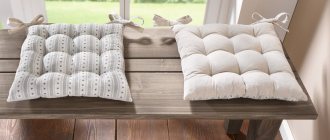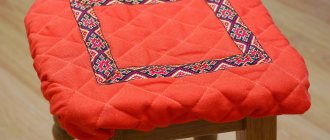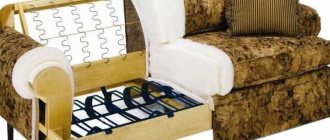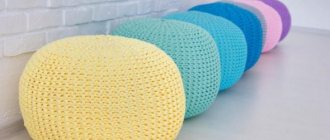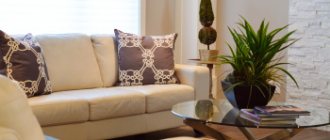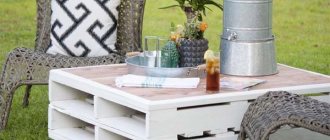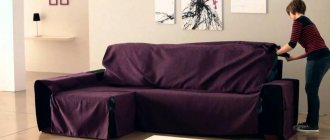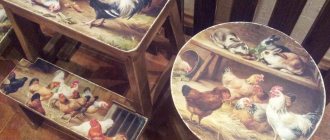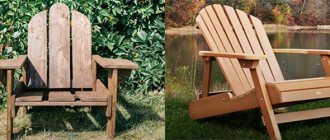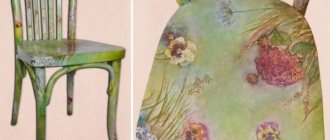How to choose fabric, filling and accessories
Before sewing a beautiful product for decoration, including a pillow, you should carefully consider its filling and the material from which it will be made. It is important to choose fabrics that will be as easy to care for as possible. Moreover, the material should not become electrified during use and attract dust. Ideal for this would be:
- Silk, satin and similar materials;
- Satin, flannel, calico fabric and linen material;
- Fabric used for upholstering furniture or chairs.
You can use the same material as when upholstering furniture.
For a more budget-friendly and original option, you can use old clothes or parts of them. The pillow will be in a patchwork style and no one will even guess that it contains old T-shirts, sweaters and pants.
Square decorative item made of silk with an oriental motif
Filler
If you have no idea what to stuff your future product with, then you need to familiarize yourself with the list of popular materials. You should choose those compositions that will not begin to clump after a certain time. Based on this, padding polyester and cotton wool disappear immediately. You should also not use feathers or down for these purposes, as these materials do not hold their shape well and are suitable for sleeping products.
Fillers
The most preferred options are:
- Holofiber, which can maintain its characteristics for 10 years of operation;
- Silicone, or rather its granules. Ideal for children's products. They are practical in that they can be taken out to wash the pillow and put back in;
- Natural materials such as hop cones, buckwheat husks, aromatic herbs.
Natural filler
Accessories
To sew a decorative pillow yourself by hand or on a machine, you will need threads of a certain color and number. Usually from 40 and above. In order to embroider on the product you will need floss. If the base of the pillow is knitted, then use almost any yarn. If the product cover is removable, it may require buttons or a zipper.
You might be interested in this All about patterning and sewing a sundress with buttons on the front
Floss threads will be an excellent pillow decoration
How to stuff a pillow with padding polyester
To prevent your neck from hurting during use, you need to place the “filling” in accordance with certain rules. It is important to know how the padding polyester is distributed inside the cover correctly, how much material to stuff in and how to prepare it.
The filling principle depends on the type of padding polyester. If you purchased sheet material, then it is enough to fold the sheet 3-4 times and cut out the blank. The figure must correspond to the parameters of the pillowcase.
Stuffing the pillow with padding polyester
Sintepon, which is scraps, must be laid gradually, filling the space from the bottom of the pillowcase to the top. You need to prepare identical scraps of material in advance, and only then start laying. After stuffing, you need to lie down on the workpiece and evaluate the level of comfort. If necessary, you can add or remove excess. Afterwards it remains to sew up the left hole.
You might be interested in this About fabric ceilings: advantages and disadvantages of fabrics
Note! During use, the material will become confused and crumpled, so it is important to prepare it correctly. How to fluff padding polyester? You need to ruffle the pieces of workpieces, separating the fibers as much as possible.
What tools will you need?
Tools are prepared in relation to what the design element will be made of and what shape it will be. If you want to knit a base, then, of course, you will need knitting needles or a hook and yarn. For decoration the following will come in handy:
- Needle, thread, sewing machine;
- Paper, tracing paper or cardboard for the diagram;
- Chalk or soap, a special pencil;
- Scissors.
It is important that the color of the pillow matches the overall design of the room.
Schemes, patterns
The first thing to do is create a pattern. Only experienced professionals can sew any products “by eye”. And the result of such a negligent attitude will not always be a smooth, neat thing. It’s convenient to use the pattern - just calculate the measurements on paper to avoid mistakes.
Modeling the pattern will make the sewing process easier. It will also be possible to create as many identical products as you like according to the same design.
Pattern for a product in the shape of a cat
Creating a pattern takes place in several stages:
- We determine the size, draw a square or rectangle on paper, add 1.5 cm on each side.
- We transfer the pattern to the double fabric, sew it together, leaving a small opening for stuffing, and turn it inside out.
- We make a pillowcase. We make a second pattern, different from the first in size - each side should be a couple of centimeters larger.
If you have experience creating similar products, you don't have to limit yourself to a square or rectangular shape. It's best for beginners to start with. You can create more interesting patterns:
- owl;
- “boa constrictor” - under the head;
- elephant, etc.
Easy to sew with your own hands
To implement any of your ideas, you just need to draw them on paper, then transfer them to fabric. Still, in most cases, when they are intended for decorating a hall or living room, it is better to choose classic options. They will be rectangular or square in shape.
Uncover
After the pattern was ready, I placed it on the fabric and attached it with pins. It is necessary to cut three such parts from the material. It is worth remembering to leave seam allowances. These centimeters must be added directly on the paper or left around the perimeter directly on the fabric. To ensure the perfect shape (both sides should be the same), you need to fold the pattern vertically.
Why French children behave well: eight ways to raise them
A student at the Vietnam Police Academy shared how she takes care of her facial skin.
“We are still friends”: Derevianko commented on the breakup with his wife
After that, I folded the parts horizontally and made a small cut on the right and left sides. It is recommended to process the finished parts using an overlocker or using a sewing machine with a zigzag stitch mode.
Master classes. How to sew?
The easiest way is to take a finished item and decorate it, making it suitable for the design of the room. Some needlewomen decide to create everything with their own hands; for this it is not enough to create a pattern. It is necessary to pay attention to such points as the choice of fabric, padding, threads. It is necessary to move on to solving decorating issues only after a successful attempt to sew it.
Textile
When deciding which fabric to choose, you need to consider not only the availability of the material, but also its suitability for the chosen style. The texture and color must be suitable and complement the overall design of the room.
The most commonly used materials are:
- linen;
- cotton;
- sackcloth;
- velours;
- fleece;
- jeans;
- atlas;
- fur.
The texture and color of the fabric should be suitable for the interior
Advice As for the use of fur, you can use both artificial and natural ones. However, for children's rooms and people with allergies, artificial ones can cause harm.
In some cases, several types of fabrics may be used, however, it is important to ensure that they are compatible. Otherwise, they will not be easy to sew, the finished product will turn out sloppy, and it will be difficult to decorate it. Experienced seamstresses adhere to the following rules:
- The selected fabric may not match the upholstery of the sofa or other furniture that the product will complement. It in itself is a design decision, the feature of which can be emphasized.
- The color of the fabric may also differ from the shade of the furniture, but they must be combined with each other. If the sofa is brown, the appropriate color for the additional elements would be orange, yellow, or beige.
- If there is a pattern on the fabric, it should not be too smeared. A bright, multi-colored pattern becomes a separate design element. In this case, further decoration using different techniques is inappropriate.
- It is necessary to pay attention to the rules of care for the selected material. Sooner or later it will have to be washed, especially if it is made in light colors. The simpler the material, the easier it will be to care for.
- When choosing fabric, it is important to think about the padding of the product in advance. If hard feathers are to be used, the material must be strong enough to hold them.
Tip If you don't have a clear idea of design, choose natural fabrics. A good option is linen, cotton, based on them, think about the model and decoration.
Padding
There are three main options for possible packing:
- natural;
- vegetable;
- synthetic.
Natural materials are:
- wool;
- feathers;
- fluff.
Their main advantage is safety of use, however, not everyone has the opportunity to purchase such materials. Some people decide to dissolve old down products and use the material they contain, but this is also not safe.
Choose natural fabrics
Over time, all kinds of living creatures grow in natural stuffings, especially if the products are not dry-cleaned and are not provided with proper care. The result may be that a person will develop an allergy, even if he is simply in a room where no one sleeps.
If you want to make stuffing from natural material, be sure to use new one. Don't forget to provide him with the necessary care.
Plant filling has a short service life, because the plants require replacement. Often used:
- medicinal herbs;
- bamboo;
- hop cones.
It is believed that such material is very beneficial for health. It is important to consider that if medicinal properties are indeed present, they will not last long. In this case, a small amount of moisture will be enough to cause rot to form.
Natural materials - safe to use
Synthetic materials have the fewest disadvantages, which is why many choose them. The most commonly used are synthetic winterizer, foam rubber, and holofiber . These padding materials are affordable, budget-friendly, and do not cause allergies. If it is not possible to purchase such materials, you can use those that you have at home:
- cotton wool;
- fur;
- silicone balls
Threads
When choosing threads, two important factors must be taken into account: they must be of high quality so that the product does not come apart at the seams. They should also be combined with the chosen fabric. The basic rules are:
- The threads must match the fabric in color. The more suitable the shade is chosen, the less attention the applied seams will attract.
- If it is not possible to use a precisely selected shade, you need to choose several tones darker. When the thread is lighter than the fabric, unnecessary attention is focused on it.
- The threads must match the width of the fabric. Too thin ones will not be able to firmly hold the material together; too thick ones will simply tear it apart. Those used for decoration must also be of a suitable width so that the embroidery or other pattern looks neat.
- If you will use a machine when sewing a product, you must choose the right needle for the thread. In addition, the upper and lower threads must be the same.
You can combine different colors and textures
The most common type of thread suitable for sewing many products is cotton, especially combined with natural fabrics: linen, cotton. Depending on the material, polyester, viscose, silk, and wool threads can also be used.
Step-by-step instruction
After selecting fabric, padding and threads, you can move on to sewing. The easiest way is to use a machine. But if this is not possible, you can make neat seams with your hands, no worse. If you are making a product with your own hands, you will need the following tools:
- scissors;
- ruler;
- marker or chalk (depending on the density of the selected fabric);
- needle.
Step-by-step instruction
- We turn the fabric inside out, fold it in half, measure the expected length and width. Then we draw straight lines under the ruler with a marker or chalk.
- We cut out rectangles or squares along the drawn lines; for convenience, you can pin the folded fabric in half with basting needles. We put them next to each other “face to face” - if unevenness suddenly arises, we level them.
- We sew three sides completely, and the fourth half, the stuffing will be inserted through it. You need to sew using a regular line stitch, no different from a machine stitch. The smaller the stitches, the neater the finished product will look.
- We turn the sewn cover inside out, stuff it through the side that is left unsewn, and carefully sew that too.
- The product is ready for further decoration.
Instructions:
- Make 2 squares of the same size from linen and crepe satin. These will be the front parts of your pillow cover.
- Fold the squares so that the crepe satin square is right side up. Baste along the edges.
- Cut out the products from pieces of colored crepe satin. It can be anything: animal faces, birds, plants, fruits, vegetables, buildings, stars, etc. This way you can create a whole picture on the pillow.
- Baste the 1st applique, remembering to fold the edges. Leave a small hole at the end so you can stuff the padding polyester.
- Sew on all the appliqués to create a picture. Applications can also be filled with padding polyester to make them look voluminous.
- Use crepe-satin in the main color to cover the back side of the pillow, which is made up of 2 parts. Sew a zipper between the pieces. Place all finished parts of the case with their right sides facing each other. Sew them together and turn them inside out through the open zipper. The pillow with the applique is ready! She can decorate any room, especially a child's room.
A DIY pillow is a great way to add a fresh and vibrant touch to your interior design. You can sew a contrasting and unusual pillow or limit yourself to a classic option that suits your home design.
Surely, the thought sometimes occurs to each of you that the usual, even the most sophisticated home interior looks somehow boring and monotonous, but in order to update the decor a little, there is neither the money nor the time. But in fact, to make changes to a boring environment, you don’t need to rearrange the furniture or re-glue the wallpaper; you just need to add a few decorative elements, for example, cute pillows that you can sew yourself from a wide variety of materials. So, if you are interested in how to sew a pillow with your own hands
, you just need to come up with a model of the future product and select a fabric that matches the design of the room, and then, armed with a needle and thread, begin to implement your plan.
As you know, a pillow can be used not only for its intended purpose (for sleeping), but also serve as a wonderful decoration for a bedroom, living room or children's room, creating colorful “spots” in those corners that look especially dull. Decorative pillows fit organically into your home interior if you carefully consider their shape and color combination, that is, for a children's room you can use the boldest colors, and for the bedroom calm colors, for example, pastels, are more suitable. If you don’t know how to sew a beautiful pillow with your own hands
, which will not only be original, but also easy to use, you need to take into account some nuances:
Having decided on the design of your future craft and having prepared all the necessary materials and tools (scissors, ruler and chalk), you can get to work. If you decide to make a cute pillow for the first time, try sewing a rectangular or square-shaped product first. So, knowing what and how best to sew a nice pillow with your own hands
, use the following tips:
Fold the finished rectangle in half, wrong side out, and sew it on the sides. Make the lines in two rows. Then, the sewn base needs to be turned out and filled with filler. We sew the third side from the outside, tucking the edges inward. Thus, you have completed the main part of the product, after which you can start sewing an elegant pillowcase.
- In order to sew a pillowcase, you need to cut out two square pieces of the desired size and sew them on three sides. On the fourth side you can make a zipper or sew buttons with eyelets.
Another option is to initially cut out one of the parts (the one on which there will be no decor) 20 cm longer, and then fold this “extra” part inward and stitch it on the sides from the wrong side. We decorate the finished cover on one side with decorative elements and put it on the pillow.
At the beginning of my first MK, a small digression and a nod to three wonderful sisters-craftswomen whom I was lucky enough to meet in the late 90s.
Representing the working core of one small company specializing in sewing textiles for the home and aimed at wealthy fellow citizens of our country, these girls made bedspreads, curtains, pillows and other elements of bourgeois beauty of incredible beauty and amazing craftsmanship. Our office was located next to the workshop. Curiosity and a sense of beauty led me to them, made me friends and made me want a blanket for our bed. What is typical is that they gave me “not a fish, but a fishing rod” and step by step, stage by stage, I sewed a blanket, large, quilted with elements, processes inherent in luxury work - you, I believe, can imagine how dear and significant it is to me. From there, from those times, the legs, and I would say the hands, of this master class grow. This MK is more of a reminder and a lifesaver for those who are lucky enough to have pillowcases of non-standard sizes that cannot (!) be cut.
In my case, there are two pillowcases (more on them a little later and with love) - 38x38 and 42x42 cm.
The steps are given as an example of one of them, but I will give photos from both pillows. Stage 1: Cut out squares from padding polyester (I use grade 300, 300 is grams per square meter)
2 pieces - 38x38 cm. Next - 2 pieces. — 33x33 cm, 2 pcs. — 28x28 cm, 2 pcs. — 23x23, 2 pcs. - 18x18 cm. As you understand, I reduce on each side, each subsequent square by 2.5 cm. This value can vary from 1.5 to 4 cm depending on the final potbelliness of the pillow and your subsequent experience. I posted my experience)
It looks like this.
This is for another pillow - there were more layers, I wanted it a little thicker.
You have two pyramids, one of them now needs to be turned over and connected, like this...
Stage 2: We fix this structure around the perimeter.
And we stitch it... I’m in my arms, it’s more convenient for me. Do you feel potbellied, lively, I would say? Like pillow candy.
Stage 3: This is the case. We are sewing a luxury pillow for you. From cotton fabric and cotton filling for quilts (M 100) I cut out two squares 40x40 cm (1 cm seam allowances on all sides). I draw stitch lines with a chalk pencil and fasten the materials together in pairs. /Cotton filling for quilts is a wonderful material, but you can also replace it with thin padding polyester if you have it on hand./
We sew along the marked lines as we please and as the machine allows.
Stage 4: We connect, adjust, sew (we left 1 cm on each side as an allowance!), leaving a distance unsewn that is convenient for further immersing the pillow in the cover, and trim the corners.
Wow...
We combine the ingredients... using a hidden seam we finish the job...
Holofiber is a synthetic filler that is used not only for sewing winter clothes, but also in the manufacture of blankets, pillows, and upholstered furniture. Holofiber does not cause allergies, does not cake over time, pillows with it can be washed in a regular washing machine at 40 degrees in a warm soapy solution. More details about fillers were discussed at Samoshveyk.
If you decide to sew a holofiber pillow yourself, you need, first of all, to buy the filling itself. I ordered it through the online store. I purchased colored calico for the cover.
The advantages of sewing pillows yourself at home are obvious - you will know exactly what materials your product is made of, as well as the ability to make a pillow of any size and configuration.
How to sew a sleeping pillow with your own hands
A hand-sewn pillow will meet all the quality standards of a housewife and will save money on purchasing store-bought analogues. After preparing the appropriate filler and accessories in the form of needles, threads and fabric for the bedspread, you can begin to work. First, you need to determine the size of the future product. Standardly it is 70 by 70 cm, and according to the European standard - 70 by 50. If you deviate from these standards, you will also have to sew a pillowcase yourself.
The process of sewing a decorative pillow in the shape of a flower
The step-by-step sewing instructions are as follows:
- The canvas is laid out on a flat table or on the floor. The fabric is measured. For example, if the future pillow is 50 by 50 cm, then you should measure 50 by 100 cm. Draw marks and lines with chalk, add 2 cm allowances to them on each side. The result will be a cut of 54 by 103 cm;
- Fold the rectangle in half and iron. Pin future seams with sewing pins and baste;
- Sew along the lines marked earlier for the seams. Previously, this was done by hand, but now machines are used;
Decorative item from an old sweater
- Sew the corners, making small roundings. Leave 10 centimeters of unsharpened space on one side. Overcast the napkin and secure the seams by cutting the threads;
- Turn the base inside out and straighten all the corners, ironing them;
- Fill the product with the selected filler through the gap left without a seam;
- Sew the seam in any way, making it hidden. Beat the product with your hands.
Breastfeeding pad pattern template
Instructions:
- To make a pillow with your own hands, you will need patterns. To do this, cut out a rectangle measuring 55x49 cm from a plain fabric.
- From fabric with an ornament, cut out 2 rectangles measuring 16x49 cm.
- Cut out 2 squares of patterned fabric, measuring 20x20 cm.
- Cut out 2 strips of plaid fabric, measuring 5x49 cm.
- Once you have cut out all the main parts, start making the ends of the side panels. Fold the cut out square of patterned fabric in half and then 1.5 times more. Draw an arc, cut along the drawn line. As a result, you should end up with a circle. Do the same with the other square. Gather the circles, leaving 1.5 cm from the edge.
- Connect the rectangles of the middle part of the bolster and the side panels. Fold the resulting rectangle lengthwise. Sew the edges together, leaving a 15cm long hole in the middle of the seam.
- Take the plaid strips, fold them in half and sew the edges. Turn out the resulting circles, bend them in half and iron them.
- Connect the plaid circles to the side panels and stitch. Sew the ends of the roller. Turn the finished pillow-cushion inside out, fill it with filling and sew up the hole with a hidden seam.
How to sew a pillow from leftover fabric
If there is no suitable fabric, but you don’t want to go to the store or your wallet doesn’t allow it, then you can use scraps and scraps of old things or materials that are left over after upholstering furniture. The general instructions are:
- Development of a diagram and order of arrangement of elements on the front side of the pillowcase;
- Cutting leftover fabric according to the pattern;
- Sewing elements and decorating them with lace, braid and other elements.
It's easy to sew a pillow from leftover fabric.
Another way is to use stencils and acrylic paints on fabric. After sewing the cover, the design is applied to the front part with a pencil and then painted over.
Important! Drawings with black outlines look interesting. Such products can be presented to family and friends, depicting their hobbies or names on them.
Small pillow painted with acrylic paint
Sewing the back of the pillowcase
To make the pillowcase neat, be sure to finish the edges of the back side with an overlock or zigzag stitch. Ideally, you can do the same with each square piece, then your product will look its best. But since microfiber or other elastic material hardly crumbles, you can limit yourself to only processing the sides of the back side. After this, you need to fold the side edge of one of the sides twice on the two parts (where they overlap one another). Leave the other three sides open.
Lost weight: what Sofia Tarasova sacrificed for the sake of “VIA Gra” (new photos)
"Dad is offended." Agata Muceniece about her relationship with Priluchny after the divorce
If there is little snow, there will be no harvest: December 16 is Ivan the Silent Day
Padding
Read more about stuffing. First of all, you need to look at the properties of the filler itself, since this is the main characteristic of the future pillow. You can stuff the product with padding polyester or knitted tape, cotton wool and other materials that are quite cheap. In cases where stuffing is required specifically for a decorative model, it is important to approach the process of choosing filler more seriously.
You might be interested in this Instructions for manual sewing machines Podolsk with foot drive
Appearance of holofiber
The main properties that the material must have:
- Sufficient elasticity. When pressed, the product should quickly restore its shape and not leave dents if people sleep on it;
- Breathability. All materials, including those from which the base, cover and padding are made, must allow air to pass through well and allow the skin to breathe;
- Hypoallergenic. All these materials must also be safe for human health and not cause allergies or skin irritation;
- Easy to care for. The pillowcase, cover and pillow itself should be easy to wash and machine washable.
Sintepon
By type, padding is divided into three categories:
- Artificial material;
- Natural material of plant origin;
- Natural material of animal origin.
Hop cones for stuffing
Artificial padding
Artificial materials have a number of properties that put them on the same level as natural ones. Moreover, they also have their own distinctive characteristics. This composition does not allow dust mites to develop and will not cause allergies. Synthetic materials are easier to wash and dry quickly.
Foam pillow
The most commonly used artificial paddings are padding polyester and holofiber. The first option is budget. Sintepon is used not only for this, but also in the manufacture of clothing.
Important! A significant disadvantage of padding polyester is that it quickly falls into clumps and does not recover its shape well. If such a pillow is actively used, then tubercles will quickly appear on it, and its surface will become hard.
Pillow in the shape of a scops owl
That is why the best choice would be holofiber, a non-woven material consisting of interwoven polyester fibers. The space between the fibers has a porous structure and is filled with air, which makes holofiber light and warm. In addition, the composition has the following characteristics:
- Removal of moisture and water;
- Air permeability;
- High service life;
- No static electricity;
- Easy to care for and easy to machine;
- No smell.
Toy pillows in the form of cats
Vegetable stuffing
Plant materials are often used to form decorative pillows or sleep products. Among the most popular options:
- Dry herbs and algae;
- Leaves of herbs such as mint or lemon balm;
- Hop cones;
- Buckwheat husk.
Herbs can also be used as a filler
Important! In many cases, such stuffing will be beneficial to health, will add some originality to the product and a pleasant smell of herbs, which will spread throughout the room.
Cotton is also often used. A pillow stuffed with cotton will be hypoallergenic, and harmful organisms and insects will not breed in it. If you stuff the cotton correctly and take care of the pillow, you can extend its service life.
Product with cotton
Animal stuffing
Down and feathers from birds (chicken, geese, swans, ducks) are considered traditional for animal stuffing. The pillows are light, soft, and quickly take shape after deformation. One drawback is that it is not advisable for people suffering from dust mite allergies to sleep on them. The thing is that over time, microorganisms can develop in such stuffing that can cause suffocation attacks in allergy sufferers. But this can also be avoided. It is enough to properly care for the item, constantly wash, dry and air it.
Sheep wool padding
In addition, you can stuff the pillow with camel or sheep wool. It will become not only comfortable, but also therapeutic, because camel hair helps people suffering from radiculitis get rid of symptoms. This material also has disadvantages: heavy weight and rapid rolling.
You might be interested in this: Simple patterns and sewing of a Scops Owls bunny toy on your own
Important! You can also use unnecessary pieces of wool yarn or an old fur coat. It can be cut into pieces and distributed evenly over the base. Such a pillow will collect a lot of dust, so it should be washed or knocked out more often.
Camel hair pillow
Design options
Here you need to give free rein to your imagination. Ideas can be very diverse, as well as techniques. Suitable decorations:
- satin ribbons, bows;
- sequins and beads;
- lace and embroidery.
It is worth taking a closer look at such popular technologies as applique and patchwork.
Puffs are a particularly impressive finish. There can be a lot of options. In any case, such pads look quite attractive and elegant.
An equally original design technique is ribbon embroidery. The result looks gentle and romantic. And the creation process itself is simple enough to be feasible for beginners.
If you want to make something truly special and stylish, play with different textures or combine several techniques at once.
Possible models
A homemade pillow is an ideal gift for a loved one or colleague. The main thing is to choose an original design.
Volumetric heart of roses
Using your imagination and a thread and a needle, you can turn an ordinary pillow into a valentine with one wave of your hand. To do this, it is enough to form the required number of buds from pink material and sew them to the finished pillow, arranging them in the shape of a heart. Such a designer product will appeal to the most demanding person. In addition, it can become the main focal point of your living room.
"Fluffy"
Pillows with fringes look quite interesting. They will suit most interior styles. It is optimal to use them to decorate a nursery, since it is difficult to find a more pleasant-to-touch option.
Pillow with butterfly applique
By using the appliqué method, you can turn even a standard pillow bought in a store into a real masterpiece that will decorate any sofa.
It is important to have desire and free time. No special skills or tools are needed. On the Internet you can easily find ready-made ideas for this kind of accessories, and if they don’t suit you, then come up with something of your own.
Pillow "Owl"
Today, funny and bright pillows in the shape of animals and birds are in fashion. The “Owl” model will appeal not only to adults, but also to children. The baby will sleep on it and play with it. This is its undoubted advantage.
Sleeping cat pillow
This is another popular type of pillow toy. A cute cat with just its appearance will make you doze off and set you up for quality rest. It will be especially appreciated by sensitive, romantic people. Sewing such an accessory is a pleasure.
Pillow "Dog"
A pillow is a man's faithful friend, so why not sew it in the shape of a dog? There are a lot of ideas of this kind. The most popular is the funny dachshund. She will gladly take her place on your sofa. Moreover, making it yourself is as easy as shelling pears.
And if you have accumulated a lot of multi-colored scraps, you can safely put them to work by sewing a colorful puppy using the patchwork technique.
Original DIY pillows are real. They are appropriate in any interior, it is only important to choose the right color and design. Therefore, do not forget, before you start work, to decide in which room you will put this product.
How to sew pillows with your own hands
First, they choose the fabric base, filling, fittings, and plan the design.
Base material:
- atlas;
- satin;
- bike;
- linen fabric;
- velvet;
- furniture fabric;
- silk.
You can take unnecessary jeans, T-shirts, textiles (patchwork style). Often people order photo printing of fabric for sewing.
The basic rule is that the quality of the fabric must be high so that the finished product does not require constant care.
Stuffing materials
When choosing a filler, its durability is taken into account. Do not use cotton wool or padding polyester. After a short time, they bunch up into clumps, just like with down filling.
Best filling materials:
- holofiber – hypoallergenic, springy, durable;
- silicone - sheet holofiber, characterized by practical properties;
- comfort - soft lumps of silicone;
- latex filler – holds the shape of orthopedic products well;
- synthetic down – soft, springy, suitable for allergy sufferers;
- fibertek - insulation for outerwear;
- expanded polystyrene - light foam balls, suitable for hard, dense padding, for anti-stress pillows;
- natural fillers - hop cones, buckwheat, dried herbs, straw, cherry pits, bamboo.
Goose feathers and swan's down require sewing a napkin and often cause allergic reactions. Sheep and camel wool does not hold its shape well and requires regular cleaning.
Pattern
Sewing both simple and complex large items begins with a pillow pattern.
The scheme can be:
- draw yourself;
- perform by analogy with the master class you watched;
- copy, take a ready-made template from a magazine or online sources for complex forms.
A beginner can easily cut out pieces of classic sizes 50x70, 40x40 and make a pillow himself.
Step-by-step instructions for cutting out the product:
- Place the fabric wrong side up.
- Secure the diagram to the fabric with pins, this is especially important if the shape of the future product is complex.
- Mark the workpiece with chalk and a special pencil.
- Allow 2-3 cm for margin and overlock processing of the contour.
- Cut on a flat surface with sharp scissors along the contour of the diagram with a margin.
To simplify the process, you can sketch a sketch on a piece of paper and place it in a visible place.
Sewing
Procedure:
- Iron the prepared piece of fabric from the reverse side.
- Pin along the edges.
- Sew from the wrong side around the perimeter, leaving a small space on one side for stuffing.
- Finish the edges of the fabric with an overlocker.
- Turn the sewn product inside out.
- Fill with the selected material.
- Sew with a hidden seam.
If you plan to install a zipper, you need to sew three sides, baste the zipper on the fourth and stitch along the basting.
Sewing ribbon
On one side along the middle you need to sew a ribbon. This will help keep the pillow in the desired position.
The ends of the tape need to be folded inward so that two loops are formed on the sides, and the raw edges are inside. You can also choose the length of the loops arbitrarily (as you wish).
Original DIY pillows
Large and small, of unusual shapes, with atypical decor, pillows decorate the interior and become real friends of small children.
Decorative sofa pillows
Scattered around the sofa with bright accents, stylized classic 70x70 rectangular elements - these handmade creations gracefully complement any space.
Sofa cushions can be:
- various geometric shapes and sizes;
- in the form of an animal's head;
- in the form of a puzzle;
- knitted;
- volumetric;
- from a whole piece or remnants of fabric;
- in the shape of a roller, heart, star, bow, box.
To prevent decorative elements from blending into the overall color scheme, choose contrasting colors and different textures.
Decor and applique options
The finished decorative pillow must be of high quality, beautiful and match the design of the room for which it is intended.
As a final design solution you can use:
- lace;
- buttons, beads;
- sequins, beads, rhinestones;
- bows of various shapes and sizes;
- frills, ruffles;
- embroidery;
- edging, ribbons, braid for edging;
- acrylic paints for fabric;
- pompoms and thread tassels;
- any available materials.
You can sew several covers with different designs in advance and change them periodically, updating the interior.
You can make appliqués yourself from pieces of fleece fabric, fur, felt, felt, leather, and ribbons. The desired shapes are cut out from the selected material and sewn to the finished pillow.
Appliques can be minimalistic or colorful, filled with details.
Three-dimensional pictures made from felt and ribbons look good.
Scops owl pillows, toy pillows
A beautiful soft toy, decorated in positive colors, will become a real guide to the world of sleep for a restless child.
Features of sewing toy:
- use only high-quality materials and filler in the composition;
- the shape of a cute animal, airplane, car, emoticon, favorite character;
- absence of small beads and elements with sharp edges in the decor.
To decorate a nursery, you can sew beautiful pillows with your own hands in a standard shape with colorful appliqués. The room can be decorated with rollers, which will create comfort and protect from drafts. They can be designed in the form of animals with a long body.
A Scops Owl can be made for a pregnant woman. It can be difficult for an expectant mother to find a comfortable sleeping position. A large U-shaped or oblong pillow will solve this problem. Subsequently, the volumetric element will facilitate the feeding process.
Pillows of unusual shape
Atypical ideas:
- donut, cake, candy shape;
- addition for kigurumi pajamas;
- fruits vegetables;
- complex geometric shapes, letters;
- flowers, leaves;
- palms, heels;
- clouds, natural phenomena;
- hugging pillow with a height of more than 1 m;
- stone stylization.
A soft element of a non-trivial shape will become a memorable gift for kids and adults. It’s easy to make pillows with your own hands using original patterns, photos, and step-by-step diagrams.
Pillow Shape
It is not at all necessary to make a decorative product of the correct shape. The most popular are rectangles and squares, but the pillow can be oval, round, or in the shape of a letter and an animal.
The most popular are rectangles and squares, but the pillow can be oval, round, or in the shape of a letter and an animal.
For each type, you must first take care of drawing up a pattern. For complex shapes, you can find options in special editions, and simple, ordinary decorative pillows can be easily made with your own hands and according to your own drawings.
It is important to immediately think through not only the shape, but also the option for decorating the pillow. This is of great importance, otherwise the product will not look harmonious. The dimensions of the pillow also need to be selected carefully. For the living room, you should not use large pillows so that they do not clutter the room. But for a nursery, you can sew a large flat pillow on which the baby will be comfortable to play, and parents will not worry that their child will freeze.
Types of pillow designs
After the pillow is ready, it is worth decorating it. There are several decorating methods that you can use.
Denim pillow
Old jeans can still be used if you make pillowcases out of them. Even if they are torn or frayed, they are suitable for hemming.
The jeans are already decorated with fringe, zippers, and various pockets. If you have several pairs of jeans, you can use separate flaps, which makes it possible to make drawings.
This material is dense and reliable; they can be filled with any filling, including loose stuffing. The pillowcases will not tear and can easily withstand washing.
Items of clothing
Old things are the best stuffing for pillowcases, as they can be used even if they are very worn.
Depending on the type of clothing, their functions may differ significantly:
- Shirt. The shirts have buttons and loops that take the place of a padlock. It is best to take flannel shirts, which are pleasant to the touch and can resist wear and tear when washed.
- Sweaters. A wool sweater, from which you can make a pillowcase, will help create a warm atmosphere in winter. The tight knitting and beautiful weaves can hold back any fillers.
Satin ribbons
Silk satin ribbons are a convenient material that allows you to quickly make a pillowcase. The weaving technique is similar to that used to make baskets or pie tops.
You can combine different colors and shades to create interesting designs. With sufficient skill and tight weaving, you can create a dense base suitable for different fillers.
Patchwork technique
A frequently used technique in design. It can be provided at the sewing stage and a pillowcase can be made from individual elements. But, if a standard pillow was made from a single-color solid fabric, the flaps can be glued on afterwards. For this, fabric glue like Moment Crystal is used. It withstands washing well and does not lose adhesion over time.
For decoration you will need pieces of fabric, which should be placed on a single canvas and glued, you can also sew them with a small stroke. This technology can be extended not to the entire pillowcase, but to small areas.
Application
The technology is similar to the previous one, but the result should be more attractive in the end. Individual pieces of fabric are sewn or glued in such a way as to create a beautiful picture.
There are 2 types of application:
- Flat. In this case, individual pieces are simply applied to the pillowcase and sewn. After this, you get a smooth picture without volume.
- Three-dimensional. This technology creates a flat picture with additional frills, bells and other decorations.
Sources
- https://tkanix.guru/krojka-i-shite/podushku
- https://modernplace.ru/dekorativnye-podushki/
- https://podelki.guru/originalnye-podushki-svoimi-rukami
- https://mattrasik.ru/pillow/podushki-svoimi-rukami/
- https://mydizajn.ru/podushki-dlya-divana-svoimi-rukami-100-foto/
[collapse]
Materials and tools for work
To sew decorative pillows, you need to prepare fabric, stuffing material, threads, needles, scissors, a zipper, an iron, paper for the pattern and the necessary decor. Of course, things will go faster if you know how to use a sewing machine, but if not, it doesn’t matter. You can sew everything by hand, using short stitches for the inside seams. To sew on external parts, you can use not only ordinary threads, but also floss or yarn.
Sewing tools
When mastering a master class on sewing a pillow, you need to select the main components.
Fabrics
How to sew a durable, practical, beautiful and original pillow largely depends on the fabric. Choose a material with which you are comfortable working and with which your ideas are consistent. It can be linen, cotton, silk, calico, flannel, felt, knitwear, burlap, satin, crepe satin, denim and fleece.
It is better to choose natural fabrics for pillows
Furniture upholstery is perfect for these purposes. It is not recommended to use stretch fabrics, which can turn all your efforts into a stretched misunderstanding.
Natural fabrics
But you don’t have to immediately run to the fabric store; sometimes you can find brilliant ideas without leaving home. Do you feel like throwing away an old, worn sweater or a favorite shirt that is torn? There is a way to make an original pillow out of them. Old clothes, jeans, scraps of fabric are excellent materials for this.
Needlewomen who know how to knit and embroider don’t have to worry about the design of their creation at all - such covers will be the warmest and brightest.
Padding
Nowadays, there are excellent hypoallergenic materials for stuffing that do not lose their shape and elasticity over the years, which are ideal for stuffing any pillows. These include:
- synthetic fluff;
- fibertech;
- Holofider.
Sintepon and foam rubber tend to lose their shape a little, but they are quite suitable for decorative pillows.
Pillow fillings
You can also use fur or pieces of fabric for stuffing. Especially if the pillow is not evenly shaped, has a large volume and is made of rough material.
Separately, we can say about silicone granules. Not only do they not get wet, are easy to clean, and can be filled through a small opening in the pillowcase; pillows with such filling can be called anti-stress. Touching them relaxes and ensures a carefree sleep.
Natural down and feathers can also be used, but they are not as easy and convenient to work with as synthetic materials, and they can also cause allergies. The advantages include the long service life and disinfecting properties of down, contrary to the prevailing myth that down and feathers are keepers of dirt and parasites.
Feather pillow
